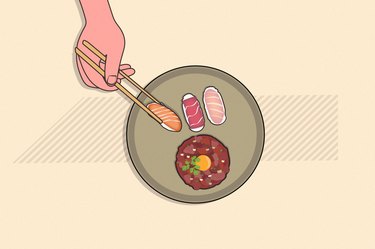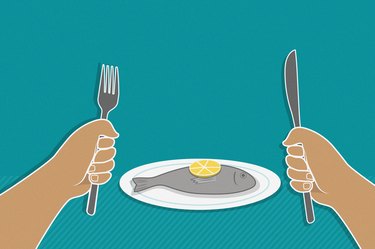
Digging into a delicious poke bowl or a plate of beef carpaccio can be a dreamy escape for your tastebuds. But the reality is that there's always a risk of food poisoning when you're eating raw fish or meat.
That's because raw or undercooked fish and other seafood, as well as meat and poultry, are most likely to be contaminated with illness-causing bacteria, such as Campylobacter, Salmonella, Clostridium perfringens and E. coli, according to the Centers for Disease Control and Prevention (CDC).
Video of the Day
Video of the Day
That said, it doesn't mean you need to completely eliminate raw fish and meat dishes from your diet. Raw fish and meat can provide some of the same nutritional benefits as their cooked counterparts.
Here, we outline the pros and cons of eating raw fish and meat, plus share some food safety tips to help you safeguard your health so you don't end up in the toilet — or worse, the hospital.
Are There Any Benefits to Eating Raw Fish and Meat?
Just like their cooked versions, raw fish and meat provide a generous amount of protein, as well as iron, zinc and omega-3 fatty acids, says Michelle Jaelin, RD, a dietitian based in Ontario, Canada.
Protein
A 4-ounce piece of raw grass-fed steak has about 26 grams of protein while a 4-ounce raw piece of wild salmon has about 23 grams of protein.
Still, cooked meat and fish are high in protein and eating them raw.
Vitamins and Minerals
Meat and fish are both high in B vitamins, iron, zinc and more.
"There have been some studies that show that when you cook meat, it decreases some of the bioavailability of certain minerals as well as B vitamins, which makes sense because they're water-soluble," Jaelin says. But it can also increase certain nutrients.
For example, a January 2009 study in Meat Science found that cooking meat decreased the amount of calcium, sodium, potassium, magnesium and phosphorous in six different meat cuts, including beef rib-eye, brisket, pork neck steak and belly, veal chop and rolled breast. But, cooking was found to increase the amount of iron and zinc in beef.
And a July 2017 study in PLOS One found that there were no drastic changes in fatty acid profile in salmon and Chilean jack mackerel when oven baking, microwaving or steaming the fish compared to the raw version.
Summary
Cooking seems to decrease calcium, sodium, potassium, magnesium and phosphorous in meat while increasing iron and zinc. And cooking doesn't significantly affect the healthy fat content in fish.
So there's no reason to be concerned that eating proteins cooked provides any less of a benefit than eating them raw. The risk of eating raw proteins outweighs any potential benefits.
Food Poisoning Risks From Eating Raw Fish and Meat
Ultimately, the greatest of eating raw fish or meat is becoming sick with a foodborne illness. "Bacteria like E.coli and salmonella are the biggest concerns with eating raw meat, and with raw fish, you're concerned with parasites and tapeworm," Jaelin says.
Common symptoms of food poisoning, per the CDC, include:
- Upset stomach
- Stomach cramps
- Nausea
- Vomiting
- Diarrhea
- Fever
These risks are notably higher when you're preparing raw food dishes at home versus dining out or ordering takeout. The cons of eating raw fish and meat outweigh the benefits when you're preparing these dishes at home because the everyday consumer doesn't have food-safety training, Jaelin says.
"Restaurants and their suppliers should have procedures in place to control the hazards associated with serving raw fish that is intended to be eaten raw," says Courtney Rhodes, spokesperson for the Food and Drug Administration (FDA) Center for Food Safety.
"Typically, raw fish sold at grocery stores are intended to be cooked before consumption and the fish may not have been processed with the same controls as fish that has been processed with the intention of being eaten raw."
When you're dining out, the chefs at the restaurant should be able to prepare raw fish or meat in a way that minimizes your risk for foodborne illnesses.
"A skilled sushi chef knows how to prepare the salmon, for example, and take a certain part of the fish that hasn't been exposed to bacteria. It's also kept at a safe temperature so it's never served hot. It should be safe but it doesn't mean that there isn't a risk," Jaelin says.
How to Prepare Raw Fish or Meat Dishes Safely at Home
Preparing raw fish or meat dishes at home can also put you at risk for cross-contamination, when you prepare vegetables and raw fish or meat on the same chopping block.
In fact, 1 in 6 Americans will get sick from food poisoning, according to FoodSafety.gov. To help you stay healthy and keep your family safe from food poisoning, follow these tips.
1. Talk to Your Butcher or Fishmonger
If you're planning to prep any raw fish or meat dishes at home, Jaelin advises talking to your fishmonger or butcher and explaining to them how you're going to use food so they can provide some safety tips.
"They can offer suggestions on what type of fish or meat is best for the dish and prepare it for you in a way that is safe for you to do that," she says. "They should be trained to know what would be considered safe for certain dishes."
2. Use Separate Cutting Boards
If you're preparing a dish that calls for fresh vegetables and raw fish or meat, be sure to use different cutting boards, knives and any other cooking utensils.
"If I have one cutting board that I love to use, I would clean my vegetables and cut them on the board first, and then wash it with soapy hot water and wipe it clean and use it to prepare the meat or fish," Jaelin says.
When storing raw fish or meat at home, place them in containers or sealed leakproof plastic bags in your fridge until you're ready to eat it, per FoodSafety.gov. Ideally, your fridge should be set to 40 degrees Fahrenheit or below.
Be sure to also keep raw meat, poultry, seafood and eggs separate from other foods in your fridge.
3. Avoid Vaccum-Sealed Proteins
Jaelin recommends avoiding packaged or vacuum-sealed fresh or frozen fish or meat because those foods have been prepped for cooking.
"They usually have safety cooking temperature suggestions. They've been prepared with the intention that you're going to cook it and eat it at home instead of eating it raw from the package," she says.
4. Eat Raw Food as Soon as Possible
Let's say you're putting together a poke bowl or sushi rolls at home, and you're combining cooked rice with the raw fish. Jaelin recommends eating it right away and avoiding letting it sit for hours because that can cause bacteria to harbor and multiply.
"Controlling time and temperature exposures is very important for the safety of all perishable seafood products, including sushi," Rhodes explains. "In general, perishable food left out at room temperature for more than two hours should be discarded, unless the temperature is above 90°F, then the time is reduced to one hour."
So always throw leftover food away that's been exposed for an unsafe amount of time or exposed to certain temperatures. Generally, Jaelin doesn't recommend saving leftover raw fish or meat dishes in the fridge for the next day.
If you're purchasing ready-to-eat sushi at the grocery store and don't plan on eating it right away, Jaelin suggests storing it on the top shelf of your fridge when you get home — away from your other foods — and enjoying it the same day.
5. Toss Anything That Looks Suspicious
Mold, which can grow in food even under refrigeration, is a sign of spoilage, Rhodes says. Although mold isn't a big health threat, it can make food unappetizing, so your safest bet is to just throw it away.
Fish fillets shouldn't have any discoloration, darkening or drying around the edges, per the FDA. They should also have a fresh or mild smell.
And beef should have a burgundy or purplish color if it is in vacuumed packaging and hasn't been exposed to oxygen. If it has been exposed to air, the meat turns bright, cherry red — this is normal if it's being refrigerated. But if beef turns brown during extended storage, it might be spoiled, per the USDA.
But food doesn't have to look, smell or taste spoiled for it to be packed with pathogens.
"Foodborne illnesses are caused by pathogenic bacteria, which are different from the spoilage bacteria that make foods go bad," Rhodes explains. "Many pathogenic organisms are present in raw or undercooked meat, poultry, seafood, milk and eggs, as well as fruits and veggies. Keeping these foods properly chilled will slow the growth of bacteria."
Tip
Visit the FDA for more safe food handling tips and storage advice.
So, Is Eating Raw Fish or Meat That Bad?
Chowing down on some raw fish or meat every now and then might be OK for most people if you follow food safety protocols — but even if you've got a robust immune system, there's always a risk of getting a side of pathogens with your meal.
For people with a weakened immune system, pregnant people, young children or older adults, the risk of developing a foodborne illness is even higher, according to the CDC.
It's best to eat raw fish or meat right after it's been prepared to reduce your risk of foodborne illness and to have it prepared by a trained chef versus making it at home yourself. Chefs have been schooled in food safety and know how to properly serve raw dishes while reducing the risk of food poisoning.
So how often can you go raw? Let's just say don't make it a regular habit.
"I think it's better to have your diet balanced with cooked foods, so I would enjoy raw fish or meat dishes no more than twice a month. The more raw food you eat, the more you increase the risk of food poisoning," Jaelin says.
Warning
Talk to your doctor if you have food poisoning symptoms, including an upset stomach, diarrhea, vomiting and nausea. It can take hours or days to develop symptoms after eating contaminated food, per the CDC. Some signs of severe food poisoning include high fever, dehydration and bloody diarrhea.
- Centers for Disease Control and Prevention: "Foods That Can Cause Food Poisining"
- Meat Science: "The Influence of Cooking and Fat Trimming on The Actual Intake From Meat"
- PLOS One: "Determining the Effect of Different Cooking Methods on Nutritional Composition of Salmon and Chilean Jack Mackerel Fillets"
- National Institutes of Health: "Iron"
- National Institutes of Health: "Omega-3 Fatty Acids"
- Centers for Disease Control and Prevention: "People With Higher Risk of Food Poisoning"
- Food and Drug Administration: "Selecting and Serving Fresh and Frozen Seafood Safely"
- U.S. Department of Agriculture: "Does the Color of Beef Indicate Freshness?"
- Food and Drug Administration: "Safe Food Handling"



